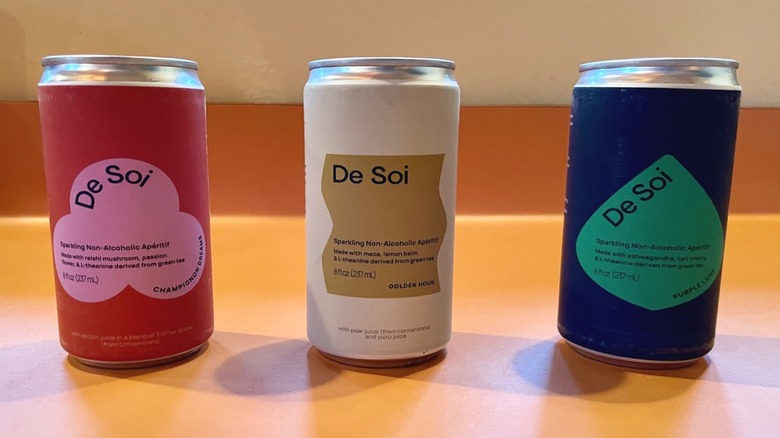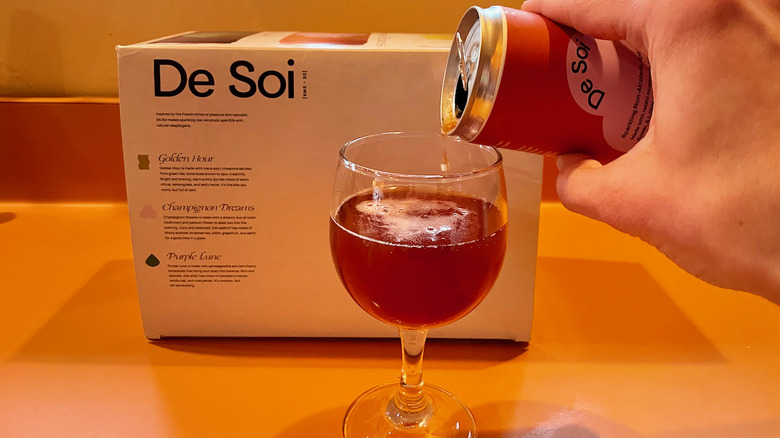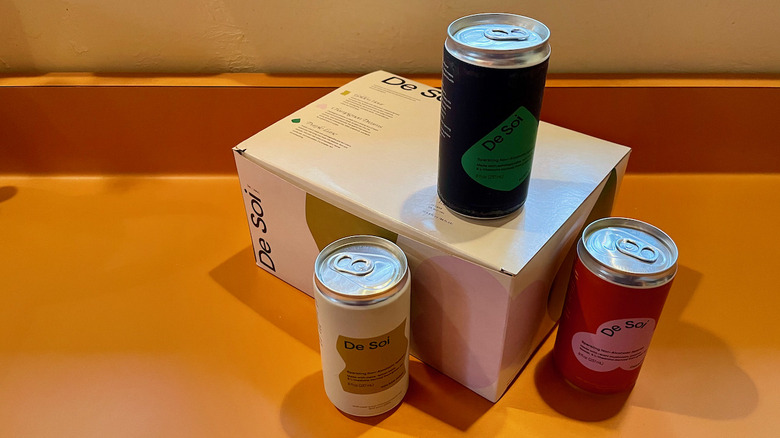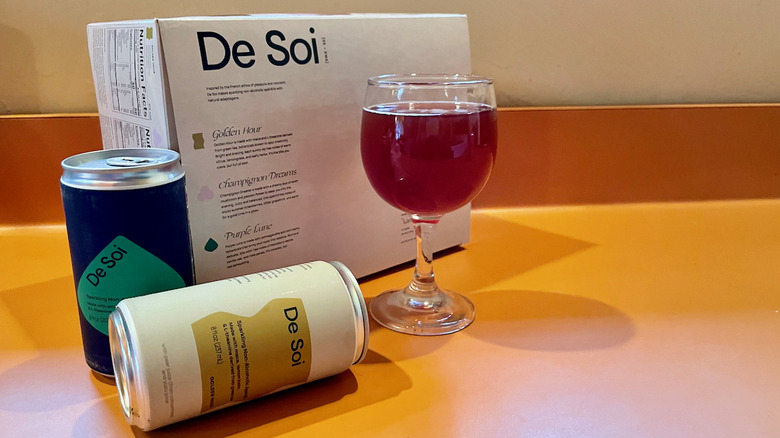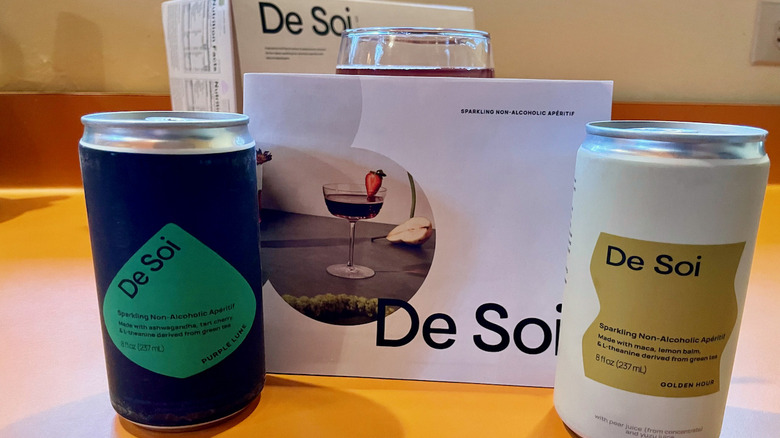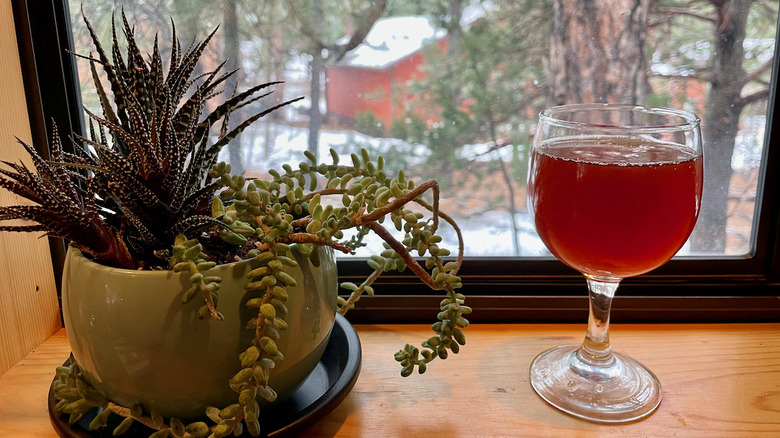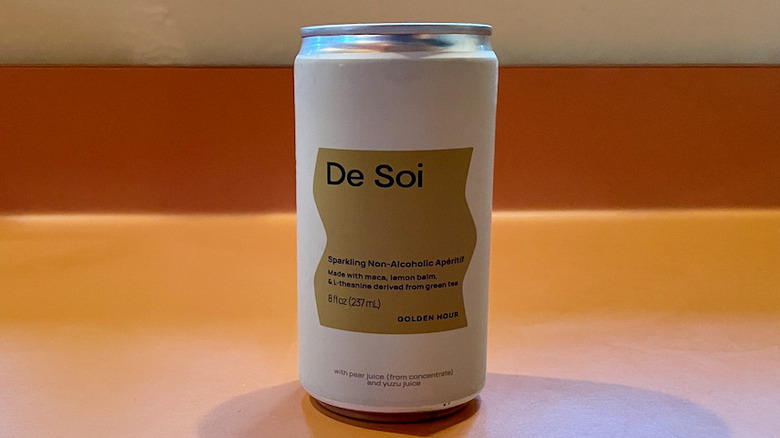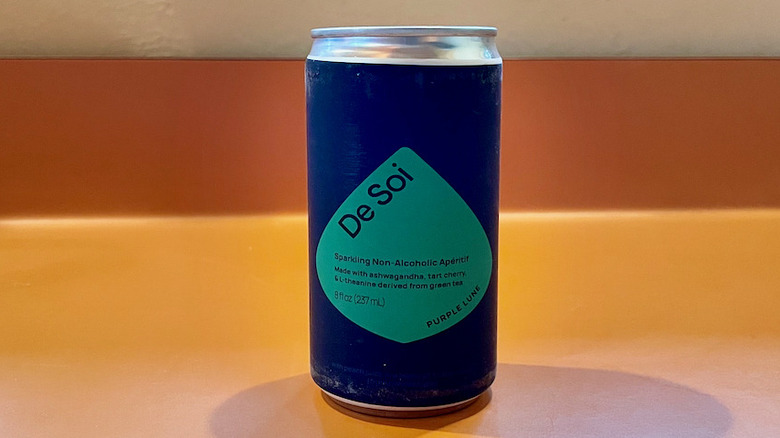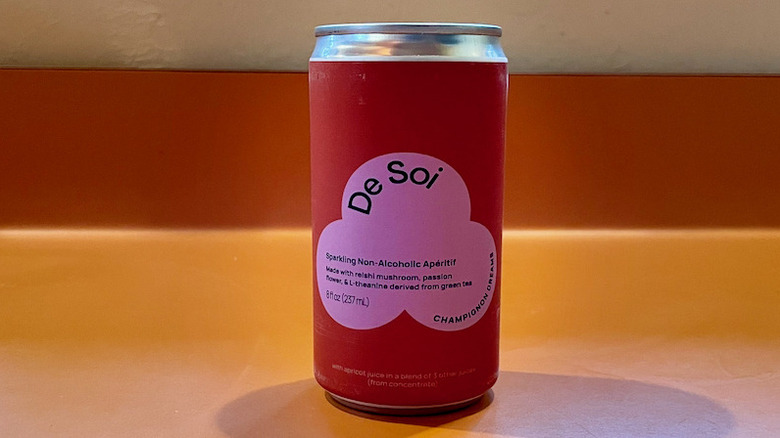We Tried Katy Perry's Line Of Non-Alcoholic Aperitifs. Here's How It Went
It seems like every celebrity is getting into the drinks business, from Ryan Reynolds' Aviation gin to George Clooney's Casamigos tequila. However, most of the celeb-endorsed beverages out there are booze, and not everybody can drink, or wants to drink all the time. Enter Katy Perry, who, along with master distiller Morgan McLachlan, has released De Soi, a line of three non-alcoholic sparkling beverages that are marketed as aperitifs. The drinks are loaded with on-trend adaptogenic ingredients that are supposed to have positive effects on your mind and body.
Whether you don't drink at all, are going for a Dry January, or just feel a little worn out from last Friday night, De Soi seeks to give you a drink with the mature flavors of a fancy cocktail sans the nasty side effects. According to USA Today, sobriety is a hot trend in the beverage world, so De Soi might be the next big thing, but it'll only succeed if its taste doesn't leave drinkers cold. We tasted all three flavors to see if De Soi is a yes or a no. Are you in, or are you out?
What's in De Soi?
Although De Soi is partially defined by what's not included in the bottle (booze), the company's beverages include a truly dizzying array of different botanicals, fruits, and extracts. By our count, the botanicals glossary on De Soi's website lists no fewer than 43 different ingredients, along with the purported health and wellness benefits of each one. It's enough to start an herbal pharmacy with, and the number of different flavorings in each variety of De Soi gives the beverages complex, hard-to-define flavors. Other than those ingredients, the only other thing in De Soi is carbonated water.
De Soi's packaging definitely looks classy. You can buy each flavor in 750-milliliter bottles that are the same size and shape as wine bottles and come decorated with an understated, matte label. If you'd rather buy in smaller containers, the company also offers 8-ounce cans. They don't look quite as fancy, but they're still designed in the same restrained yet expensive-looking style as the bottles.
How much does De Soi cost?
De Soi doesn't just look expensive — it is expensive, or at least it costs more money than you may be used to spending on a drink with no alcohol in it. Per the company's site, a bottle will run you $25, though if you buy three, it's only $23.33 per bottle, and the price drops to $22 per bottle if you buy six. The cans are a slightly better deal. A four-pack of cans (the smallest number you can buy) costs $25 ($6.25 per can) on the De Soi website, but four cans is 948 milliliters of product, a fair bit more than you get in a bottle. Like with the bottles, there is a quantity discount; if you buy 48 cans, your price per can goes down to $4.69.
If those prices make you want to "roar," they're actually on the lower end for something marketing itself as a premium non-alcoholic booze alternative. Many of the options in this Wirecutter roundup retail for $40 or more, which makes De Soi seem like a bargain in comparison. Those adaptogens don't come cheap.
Where can you buy De Soi?
As we alluded to above, you can buy De Soi directly from the manufacturer. There's no indication that De Soi is a limited-run product, so if it's a success, you can bet that it will stick around. All orders are mailed from Los Angeles, and De Soi ships to the entire U.S. Shipping is free if you buy $50 or more of the product. At the time of writing, they don't offer international shipping, but they promise that that's going to change soon.
You can also buy a De Soi subscription. If you choose this route, you sign up to receive deliveries monthly, bimonthly, or quarterly, and in exchange, you get 15% off your haul. It's kind of like a wine club, but with no alcohol involved. De Soi is also currently available from New York-based non-alcoholic beverage retailer Boisson for pickup as well as delivery.
How does De Soi compare to a normal aperitif?
So what is an aperitif anyway? As Tasting Table has covered, the word is used to describe any kind of alcoholic beverage that you drink before dinner. As such, it's a rather vague umbrella term, referring more to when you're drinking something than what it actually is.
However, in Italy, aperitif (or aperitivo) has a more specific meaning. There, it generally refers to a variety of different floral, bitter, herbal liqueurs that are often made into spritzes with carbonated water and intended to accompany snacks. We would guess that this kind of aperitif is what inspired De Soi, as the beverages are bubbly and have earthy, bitter, herbal flavors. You could drink De Soi as a pre-dinner beverage or with afternoon snacks just like a traditional aperitif, but it would also be good as a nightcap, especially since some of the botanicals in it are supposed to chill you out.
Nutrition
De Soi is definitely healthier than a lot of sweet, bubbly beverages you can buy. Depending on the flavor, De Soi has 30 to 60 calories per 5-ounce serving. While all the flavors contain some sugar, most of it is natural, with added sugars only accounting for 1 to 2 grams per serving, a modest 2-4% of the daily recommended limit. Each flavor also boasts a hefty percentage of real juice.
While the basic nutrition of De Soi is easy to verify, it's hard to know how to evaluate the claimed benefits of its adaptogenic ingredients. According to Vox, the body of research on the purported effects of adaptogens is slim, and many have not been studied enough to evaluate whether they actually do what people say they do. Additionally, De Soi doesn't say exactly how much of each supposed adaptogen is in its drinks, so even for better-studied ones like ashwagandha, there's no way of knowing exactly how much you're getting in each serving.
Now that you know what De Soi is all about, let's examine how each of the three flavors actually tastes.
Golden Hour
We don't know why this is named after another pop star's song (maybe the Kasey Musgraves reference is unintentional), but we're no branding experts. We guess it's probably because of this drink's color, which looks beautifully golden in the promo pics, but actually comes out a swampy yellow-brown-green in person (not that that matters all that much in terms of our overall enjoyment of the drink). According to De Soi, the green tea-derived l-theanine in this is supposed to be a brain-booster, while the maca enhances overall vitality and, shall we say, romantic prowess. Will this light our brains up like a firework, or will it leave us feeling like plastic bags drifting through the wind?
We can't say that this affected our brains (or, uh, any other parts of us) in any noticeable way, but it was darn tasty. The first ingredient is pear juice, which lends a noticeably thick body and a nice mellow sweetness. There are also several kinds of tea and herb extracts in Golden Hour, and they all combine to give it a pleasantly complex floral flavor, especially in the aftertaste. You can pick up even more of this herbal character in the aroma, which is warm and slightly spicy. This is the sweetest of the three flavors, and the most subdued.
Purple Lune
You could call this flavor the "dark horse" of De Soi's lineup, both because of its beautiful red-purple color, and because it starts out tasting simple, but slowly reveals its complexities as you sip. De Soi claims that Purple Lune's ashwagandha content can act as a natural de-stressor. The drink also has tart cherry juice in it, which is apparently high in melatonin, so maybe don't drink this one in the morning.
On the first sip, you get a lot of ripe fruit notes. Given the drink's provenance, you might expect cherry ChapStick, but it actually tastes more like tart blackberry. This is the most wine-like of the De Soi drinks, and it reminded us a bit of a bold, fruity California (Gurls) Cabernet. It also has some balsamic vinegar in it, which lends it a shrub-like tang.
The fruit and vinegar dominate Dark Lune's flavor, but you get other fragrances when you sniff your glass. That's when you can really appreciate the inclusion of date syrup and rose petal extract, which both punch through the dominant berry flavor in a way that's quite delightful. Like all the flavors of De Soi, Dark Lune has a moderate level of carbonation, with tiny bubbles that don't overpower the overall effect of the drink. As with Golden Hour, if we were supposed to feel something from this, we didn't, but it was worth it just for the flavor alone.
Champignon Dreams
We can only assume that the name of this is a subtle nod to "Teenage Dream," but this drink's assertive bitterness would probably make actual teenagers grimace. As classy adults with refined palates, however, this is our favorite. It pours a lovely tawny orange-pink color, and it tastes like a less-sweet Aperol or a less-bitter Campari. This beverage is the most like an actual, alcohol-containing aperitif of the three De Soi options. Its flavor made us think it had quinine in it like tonic water, but a perusal of the ingredients list indicates that the bitter flavor comes from grapefruit and a variety of herbal extracts.
The aroma of Champignon Dreams is multilayered, with notes of spice and citrus. The strongest scent is juniper, which is the signature botanical in gin, so maybe that's why this one had us thinking of tonic water. Champignon is French for "mushroom," and in this case, it's referring to the reishi mushroom powder in the drink, which De Soi says is for "straight chillin'." We actually did feel noticeably relaxed and slightly drowsy after finishing our can of Champignon Dreams, although whether that was the power of suggestion from the ad copy, our brains being tricked into thinking we were actually drinking Campari, or a real effect from the botanicals, we can't say for sure.
